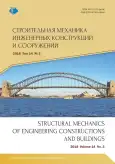SECOND ORDER STRUCTURAL THEORY FOR THE STABILITY ANALYSIS OF COLUMNS
- Autores: Galishnikova V.V1, Gebre T.H.1, Al-Sabri S.M.1, Saffia-Doe O.1
-
Afiliações:
- Peoples' Friendship University of Russia (RUDN University)
- Edição: Volume 14, Nº 3 (2018)
- Páginas: 192-197
- Seção: Analysis and design of building structures
- URL: https://journal-vniispk.ru/1815-5235/article/view/346316
- DOI: https://doi.org/10.22363/1815-5235-2018-14-3-192-197
- ID: 346316
Citar
Texto integral
Resumo
Palavras-chave
Sobre autores
Vera Galishnikova
Peoples' Friendship University of Russia (RUDN University)
Email: galishni@gmail.com
Professor, Director of the Department of Architecture and Civil Engineering, Engineering Academy, Peoples’ Friendship University of Russia (RUDN University). Research interests: computational civil engineering, building information modeling, topological computer models of buildings, computational geometry, computational mechanics of complex steel structural systems - latticed plates and shells, thin-walled plate and plate-rod structures. nonlinear finite element analysis of space frames, nonlinear stability of structures 6 Mikluho-Maklaya St., Moscow, 117198, Russia
Tesfaldet Gebre
Peoples' Friendship University of Russia (RUDN University)
Email: tesfaldethg@gmail.com
Master of the Department of Architecture and Civil Engineering, Engineering Academy, Peoples’ Friendship University of Russia (RUDN University). Research interests: questions of the stability of multi-story buildings elements 6 Mikluho-Maklaya St., Moscow, 117198, Russia
Sahar Al-Sabri
Peoples' Friendship University of Russia (RUDN University)
Email: sahar.alsabri@mail.ru
Master of the Department of Architecture and Civil Engineering, Engineering Academy, Peoples’ Friendship University of Russia (RUDN University). Research interests: metal constructions, computational civil engineering, building information modeling, computational mechanics of complex steel structural systems 6 Mikluho-Maklaya St., Moscow, 117198, Russia
Osman Saffia-Doe
Peoples' Friendship University of Russia (RUDN University)
Email: osmadoe@yahoo.com
Master of the Department of Architecture and Civil Engineering, Engineering Academy, Peoples’ Friendship University of Russia (RUDN University). Research interests: design of steel structure, structure mechanics, stability analysis 6 Mikluho-Maklaya St., Moscow, 117198, Russia
Bibliografia
- Santamouris M., Mumovic M. (2015). A Handbook of Sustainable Building Design and Engineering, 476.
- Trahair N.S., Bradford M.A., Nethercot D.A., Gardner L. (2008). The Behaviour and Design of Steel Structure to EC3. Fourth edition. Published by Taylor & Francis, New York, 490.
- American Institute of Steel Construction, Steel Construction Manual 13th Edition, 2005, 2181.
- En B.S. (2007). Eurocode 3 - Design of steel structures. Design, 3(1).
- Building Reaserch, Worked Examples for the Design of Steel Structures BRE SCI Based on BSI & Eurocode 3. 1.1, 1994.
- Revisions, January 2003, Manual of Steel Construction Load and Resistance Factor Design, 3rd Edition.
- Salmon C.G., Johnson J.E., Malh F A. (2009). Steel Structures: Design and Behaviour: Emphasizing Load and Resistance Factor Design.
- Ghosh K.M. (2010). Practical Design of Steel Structures.
- Timoshenko S.P., Gere J. (1963). Theory of elastic stability, 541.
- Chen W.F., Sohal I. (1995). Plastic Design and Second-Order Analysis of Steel Frames.
- Marshall T.P. et al. (2015). Design Guide for Low- and Medium-Rise Steel Buildings Institute, AI Mag., 13(1), 217-245.
- Ray S.S. (1998). Structural Steelwork - Analysis and Design, 582.
- Wong M.B. (2011). Plastic Analysis and Design of Steel Structures.
- Claudio Bernuzzi B.C. (2016). Structural Steel Design to Eurocode 3 and AISC Specifications.
- Williams A. (2011). Steel Structures Design ASD/LRFD, 545.
- American A., Standard N. (2010). For Structural Steel Buildings.
- Sci, Steel Building Design: Design Data, 2009.
- Beedle L.S. (1956). Why plastic design, AISCUSC Conf. Plast. Des. Struct. STEEL, No. 205, 1-28.
- Farkas J., Jármai K. (2013). Optimum Design of Steel Structures, Vol. 46, No. 1-3.
- Kirke B., Al-Jamel I.H. (2004). Steel Structures Design Manual To AS 4100 First Edition, No. June, 243.
Arquivos suplementares









